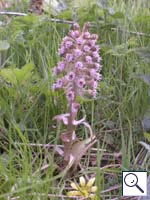|
||||||
|
PETASITES. Butterburs and Winter Heliotrope. [Asteraceae] |
|
|
Five species of Petasites are recorded in Britain. These included the native Butterbur (P. hybridus) and the introduced Winter Aconite (P. fragrans). Seven British miners miners are recorded on Petasites. The pterophorid Platyptilia gonodactyla is recorded as a stem and flower feeder on Petasites in Britain. A key to the European miners recorded on Petasites is provided in Bladmineerders van Europa. |
Key for the identification of the known mines of British |
1# > Leaf-miner: Details unknown. |
|
Pegomya depressiventris (Zetterstedt, 1845) [Diptera: Anthomyiidae]. |
1a > Leaf-miner: An upper surface corridor mine, becoming strongly broadened and blotch-like. The mine can occupy a considerable part of a small leaf. Mines frequently merge and then accommodate several larvae. Pupation external, in the soil. Upper-surface corridor, in the end strongly widened and blotchy; may occupy a large portion of smaller leaves. Mines may coalesce, and contain several larvae then. Primary and secondary feeding lines very conspicuous (picture). Pupation outside the mine. Makes upper surface blotches. |
|
Acidia cognata (Wiedemann, 1817) [Diptera: Tephritidae]. |
1b > Leaf-miner: Full depth, initially a much branched corridor, irregular in width, in the end almost a blotch. The mine has openings by which part of the frass is ejected. The larvae frequently leave the mine to restart elsewhere. Older larva live free and cause window feeding, often erasing their old mines. In Coltsfoot also pseudo-mines are made, when the larva eats away the lower epidermis with the leaf tissue, but spares the dense hair cover. |
|
Phytosciara halterata Lengersdorf, 1926 [Diptera: Sciaridae]. |
1c > Leaf-miner: The mine begins as a long, quite narrow corridor, usually not far from the tip of a leaf segment. Usually this corridor follows the leaf margin for some distance, but it may also run freely through the blade and may then be stongly contorted. In the end the corridor is directed towards the midrib, where an elongated blotch is formed, overlying the midrib and some of the larger lateral veins. Frass in a nearly continuous line in the initial corridor, in scattered lumps in the later part of the mine. Primary and secondary feeding lines very conspicuous when seen in transparancy. Pupation outside the mine. The mine starts as a very narrow corridor, usually close to the tip of a leaf segment and following the leaf margin. The later section of the corridor approaches the main vein, where an elongated blotch is made with long broad finger like extensions that lay over the secondary veins. In the initial corridor the frass forms an almost continuous line, in the blotch it is distributed in large scattered lumps. In fresh mines the secondary feeding lines are clearly visible. |
|
Trypeta zoe Meigen, 1826 [Diptera: Tephritidae]. |
1d > Leaf-miner: A long linear greenish-white mine which can conspicuously widen at end, with frass in separate grains (Spencer, 1972b: 81, 83 (figs 264-5); Spencer, 1976: 522, 523 (fig. 915). Upper-surface, quite long corridor with irregular sides, in the end about 4 mm wide. Frass in discrete grains, alternating along the sides. Pupation outside the mine; exit slit in upper epidermis. A long narrow mine, widening at the end and often forming a secondary blotch. |
|
Phytomyza tussilaginis Hendel, 1925 [Diptera: Agromyzidae]. |
1e > Leaf-miner: The mine mine begins as a long, hairlike corridor. The last part of it runs perpendicular to a leaf segment. The part of the leaf that thereby is cut off Wiltshire, and here a large blotch is made. Frass scattered in the mine. Mine practically full-depth, yellowish green to reddish brown, with conspicuous secondary feeding lines. Pupation outside the mine. See also Seidel (1926a) for an extensive description of the mine. |
|
Stemonocera cornuta (Scopoli, 1772) [Diptera: Tephritidae]. |
1f > Leaf-mine: The larva mines the leaves creating an irregular blotch. Forms an upper surface mine, with the surounding area turning purple. The frass is accumulated in one place in the mine and the larva may conceal itself under this. Initially a branching corridor, later more an elongate upper-surface blotch from the leaf base to the leaf margin, finally occupying a good part of the leaf. Most frass is deposited in one section of the mine, forming a crust below which the very agile larvae can retreat. |
|
Scrobipalpula tussilaginis (Stainton, 1867) [Lepidoptera: Gelechiidae] |
| Last updated 06-Jul-2019 Brian Pitkin | ||

